Jiaxing
Jiaxing (嘉興) is a historic city located in Zhejiang province. The historic city centre is less than an hour by train from its much larger neighbor to the north-east, Shanghai, which makes Jiaxing a popular day trip destination from Shanghai. It is also easily reached from Hangzhou, Suzhou or Nanjing. Jiaxing city also includes Wuzhen (烏鎮) and Xitang (西塘), two well known preserved canal towns, as well as the historic district of Pinghu.
Understand
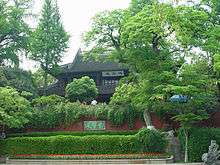
Jiaxing is more than 2000 years old. Historically, it was a strategically important town, and fought over by different kingdoms. The citadel at the city's centre is one vestige of this history.
The countryside around Jiaxing became some of China's richest agriculturally, and Jiaxing became a rich market town. In the 6th century, Jiaxing became an important stop on the Grand Canal, the 1,000km long watercourse that connected the economically important Yangtze Delta with Beijing, the political capital. Jiaxing became a popular place for scholar-officials to retire to. It was a favourite destination of the Qianlong emperor. To the emperor, Jiaxing, with its prosperous town and busy canal, combined with a beautiful lake and unspoilt countryside, was the ideal Chinese city. In the 19th and 20th centuries, neighbouring Shanghai rose up as an international port and metropolis, and modern, Western influences also came to Jiaxing. The Carmelites built one of China's grandest churches in the city centre.
Jiaxing proper is best known for historic buildings in the city centre and South Lake, a picturesque spot favoured by emperors. Jiaxing and South Lake have long been a popular day-trip destination from Shanghai, while revolutionaries have also used it as an "escape" from Shanghai. In 1921, a group of young revolutionaries whose meeting in Shanghai's French Concession had been disrupted by authorities came here disguised as daytrippers, and finished their meeting on a boat on South Lake - and founded the Communist Party of China. Between 1932 and 1936, Kim Koo and various Korean revolutionaries also took refuge here to escape from Japanese authorities in Shanghai. Jiaxing's reputation for producing and attracting the literati continued into the 20th century. Several writers' homes, and houses where prominent scholars and politicians once lived have been preserved and are now open to the public.
Jiaxing city also contains two of China's most famous canal towns - Wuzhen (烏鎮) and Xitang (西塘) - which feature preserved houses set on a dense network of narrow waterways, and are popular with visitors wanting to experience a taste of what was once typical life around the lower Yangtze delta, known as the Jiangnan region. If you have seen a Chinese period drama or kung fu movie set in a Chinese canal town, chances are it was filmed in one of these towns. (Mission Impossible III was also partly filmed in Xitang.) Wuzhen is located to the west of Jiaxing, further towards Hangzhou, while Xitang is located to the northeast, further towards Shanghai.
Get in
By rail
Visitors arriving by train usually alight at Jiaxing station, which is within walking distance to both the city centre and South Lake. This station is served by the Hangzhou-Shanghai Railway (not the bullet train). Travel time is 45-60 minutes from Shanghai, and just under an hour from Hangzhou. There are numerous trains in both directions throughout the day, but the frequency of trains can vary. Check the timetable when planning your journey. Trains from Shanghai depart from Shanghai South railway station.
You can save a few minutes on your train journey from Shanghai or Hangzhou by taking the high speed rail to Jiaxing South station, but the stations on the high speed rail line are in general all further from the city centre. You can take a cab to the city from Jiaxing South railway station.
Jiaxing will be a station on the proposed Shanghai-Hangzhou Maglev Train Line.
By coach
There are numerous long distance coaches connecting Jiaxing with all surrounding cities, including Shanghai, Hangzhou, Suzhou and Nanjing.
By car
Jiaxing is on the Shanghai-Hangzhou Highway and 320 National Highway.
By boat
The World Heritage-listed Grand Canal runs through Jiaxing. While travelling by boat used to be the main way to get to the cities and towns in this region, it has now been replaced by rail and road. Scheduled intercity boat services on this part of the Grand Canal stopped in 2006, and it is no longer possible to travel on the Grand Canal by public transport.
Get around
In the city centre
Jiaxing's taxis are plentiful and (compared to Shanghai and Hangzhou) cheap. There is also a good bus network serving the urban area. The old city is surrounded by a ring road and there are a couple of major avenues running north-south and east-west through the city that connect with the other scenic areas near the city centre, buses will usually follow either the ring road or one of these avenues. The old city itself is walkable on foot.
Jiaxing has a public bicycle rental scheme, but you need to get a special bicycle rental card, unless you already have a "city card" (issued to residents) or a public transport card. As such, this is not a practical option for casual visitors.
South Lake is served by a regular ferry service, but public transport around the rest of the city by boat ceased several years ago.
To suburban towns
To get to, and between, Wuzhen, Xitang, and other towns, a combination of trains and buses is available.
- For Wuzhen, either take a local train to Tongxiang station, then change for a bus, or catch a bus directly from Jiaxing Coach Station. Between 7am and 5pm buses run every 15 minutes from Tongxiang Station to Wuzhen. A tourist coach service also runs directly from Shanghai South Coach Station (next to Shanghai South Station) to Wuzhen. Coaches also run from Xujiahui in Shanghai to Tongxiang, where you can change for the local bus.
- For Xitang, either take a local train to Jiashan station or Jiashan South station, then change for a bus, or catch a bus directly from Jiaxing or Jiaxing South station. Some coach services from Shanghai South Coach Station (next to Shanghai South Station) run directly to Xitang (though most run only to Jiashan, requiring a change to a local bus.) Buses from Jiashan to Xitang cost ¥5.
Around Wuzhen and Xitang
In both Wuzhen and Xitang, there are buses and taxies to convey visitors between major locations such as between the train station or coach station and the preserved scenic area. Once you are in the preserved quarter, visitors mostly get around on foot. There are also rickshaws for hire and small canal boats. Some places (like the Western Quarter or Xizha of Wuzhen) have boat-buses the cost of which is closer to a taxi, while other places might only have sightseeing boats for hire with guides, which cost a lot more.
Talk
The language of the region is the Wu dialect; it is not mutually intelligible with standard Chinese (Mandarin), or Cantonese for that matter. The specific dialect in Jiaxing is very similar to that of nearby Shanghai (or "Shanghainese"), and is also mutually intelligible with the Suzhou dialect, which is the prestige dialect of Wu. However, as anywhere in China, most people are bilingual in the local dialect and Mandarin, and you should have no problem speaking Mandarin unless you are talking to the elderly.
English is less widely spoken than in Shanghai, Hangzhou or Suzhou, although staff at the better hotels and more tourist-oriented restaurants will speak some. Cab drivers, staff at local shops or restaurants or railway ticket offices are unlikely to speak any English. For prudence, have the names of your destinations written in Chinese, so that taxi drivers can get you there; carry a business card for your hotel so they can get you back to it.
See
City centre
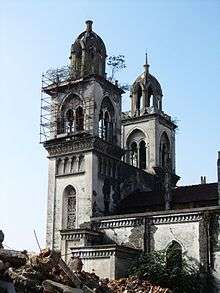
Jiaxing is currently going through a programme of unearthing its tourism assets. A number of attractions are being restored or renovated, while others have recently been refurbished.
- 🌍 St Mary's Church (天主教堂, Catholic Church), 55 Ziyang Street (Near centre of old city). Once one of China's grandest churches, St Mary's Church was built by the Carmelites near the centre of Jiaxing (just west of the Citadel - see below). Constructed over 13 years and completed in 1930, most of its construction material was imported from France, as was the bell. The church was for a long time the tallest building in Jiaxing. During the Cultural Revolution (1966-1976), the church was attacked by Red Guards, who destroyed its roof and smashed doors, windows and statuary. Rooms were later built inside the ruins of the church. The ruins are still imposing, but the interior is not open to the public at present, but the city government plans to restore the church and build a new development centred around a new church square. The neighbourhood around the church has been demolished in preparation, so at present the church sits in a large rubble field.
- 🌍 Vincent Abbey (文生修道院), 153 Guangming St (Northeast of old city, close to Yuehe Street). In its heyday, Vincent Abbey, a Lazarite (Congression of the Mission) monastery, was one of the largest Catholic monasteries in China. It is remarkably well preserved. After 1949, it became a nursing home. It is no longer open for visits, but the public can get a good view of the cloisters from the street. The city government plans to restore the abbey and turn it into another tourist attraction.
- 🌍 Citadel of Jiaxing (子城, Zicheng), Fuqian Street (Near centre of old city). Jiaxing is one of the few cities in south-east China that retains any vestige of a citadel. Located at the centre of the old city, the citadel was first built in 231AD, and remained the fortified administrative centre of Jiaxing until 1912, when it became a barracks, and later a school, and is now a hospital. Much of the citadel was demolished in the 20th century, and today only the imposing front gate on Fuqian Street and part of the wall survives. The city government is in the process of moving the hospital away and creating an archaeological park on the site of the citadel. In the mean time, the site is not open to the public, and visitors can only view the gate from the street. Nearby, on the street called Yaojia Dai, is the former residence of Shen Zengzhi, historian and poet.
- 🌍 Meiwan Street (梅灣街, Plum Blossom Bay Street). A picturesque neighbourhood in the southwest corner of the old city on the bank of the western South Lake, this area has been redeveloped in recent years, with several historic buildings restored and new buildings built in a sympathetic style. Apart from the traditional buildings - housing small museums, restaurants and bars - the area features winding brooks, willows and small lakeside parks. It is a favourite of local fishermen and also Korean tourists, who come here to see "Kim Koo's Refuge", a house once used by important members of the Provisional Government of Korea during the Second World War, and where Korean revolutionary Kim Koo took refuge after his followers assassinated an important Japanese general in Shanghai (currently under renovation by the city government). Several other historic buildings are located here, including the former residence of Chu Fucheng, an early 20th century Chinese politician who arranged Kim Koo's escape from Shanghai; Xu Yi Gu Hall, a former rice merchant; the architecturally noted former residence of Wang Huzhen (currently under renovation by the city government); and the former residence of Zhu Shenghao, poet and translator of Shakespeare into Chinese. Qingfen Hall, a family memorial hall belonging to the prominent Qian family of Jiaxing, is also here and is open to the public. Close to Meiwan Street is also the former residence of Shen Junru, prominent "third way" politician of the mid-20th century.
- 🌍 Yuehe Street (月河街, Moon River Street), Zhongji Road and surrounds. Another restored neighbourhood, this one on the north side of the old city, Yuehe Street or "Moon River Street" is named after a system of canals connected to the city moat, so-called because they are curved like the crescent moon. This used to be a centre of traditional commerce and light industry. As opposed to the elegant houses of prominent people featured on Meiwan Street, Yuehe Street features authentic shop and workshop buildings of a more "commoner" type, with numerous tea rooms, small restaurants, and sellers of Chinese cakes and baked goods. If your itinerary does not allow you to go on to Xitang or Wuzhen, Moon River Street is a good taste of what those canal towns are like. The Museum of Zongzi Culture is dedicated to the leaf-wrapped rice balls for which Jiaxing is famous. There are some large hotels in the same neighbourhood based in restored or newly built but traditional style houses.
South Lake
South Lake (Chinese: 南湖; pinyin: Nán Hú) or "Nanhu Lake" is a scenic lake located the south of the city centre, and is Jiaxing's main tourist attraction. The lake covers an area of 0.54 km². It is also known as "Mandarin Duck Lake", due to the lake's shape. The main South Lake to the east is connected to the "western South Lake", a smaller water body to the west. The lake is connected to the Grand Canal between Hangzhou and Beijing, a channel of which runs next to the northwestern shore of the lake.
Other than the mid-lake island, most of the lake's shoreline (and most attractions) are accessible for free on foot or by taxi or bus, but the best way to see the main sights of the South Lake is by boat: see entry in "Do" below. The main attractions are:
- 🌍 Pavilion of Mist and Rain (煙雨樓, Yanyu Lou), mid-lake island, South Lake (accessible only by boat, see "Do" below). The Pavilion of Mist and Rain was built in 1549 on an artificial island in the middle of South Lake, to replace a 10th century original built on the lake shore that had fallen into ruin. The pavilion and the gardens around it were improved over the next couple of centuries as a pleasure garden used by local officials and, on occasions, visiting emperors. The Qianlong Emperor loved the island so much that he added a replica to the imperial resort in Chengde. A regular ferry takes visitors to and from the island and also calls at the other main sights around the lake. The pavilion itself was last rebuilt in 1918, but is furnished largely as it was in the 19th century. Some subsidiary buildings house exhibitions. Of particular interest to Chinese Communists is a traditional wooden canal boat permanently moored at the island, a replica of a boat that served as the venue for the Communist Party of China's first conference in 1921, after the delegates escaped the police in Shanghai to continue their meeting. Called the "South Lake Boat" or the "Nanhu Red Boat", this replica boat is therefore considered the birthplace of China's ruling party. Normally open for visits for an extra ¥20, visitors are forbidden to board (and extra security guards the boat) during times of political or security sensitivity. ¥50 (including ferry); ¥20 extra for Communist boat.
- 🌍 Xiaoyingzhou Island (小瀛洲), Yuanhu Road, near corner of Nanhu Road (Ferry calls at wharf on island, alternatively walk across bridge from north-east shore). Another small island in the South Lake, close to the north-east shore, Xiaoyingzhou features a picturesque pavilion that was once a temple to Cang Jie (under restoration), the mythical hero credited with inventing Chinese characters. It is similar to the mid-lake island and was also popular with local scholar-officials for drinking and/or poetry parties. The island is connected to the lake shore by a bridge. At its southern end is a wharf which the ferry calls at. A picturesque covered bridge is located to the north east of the island - this bridge crosses a channel that connects South Lake with the Grand Canal. Continuing the theme of Chinese characters, in recent years a display of the history of Chinese calligraphy has been built on the lake shore, close to Xiaoyingzhou island. Also nearby, on the eastern shore of the lake, is the Nanhu Revolutionary Memorial Hall, a concrete monument and a must-visit destination for Communist Party members on party-education tours but unlikely to be of much interest to anyone else.
- 🌍 Haogu Pagoda / Shrine to Wu Zixu (壕股塔院 / 伍相祠), 237 Yuanhu Road (Ferry calls here, alternatively walk in from Yuanhu Road). Long a landmarks of Jiaxing, the square Haogu Pagoda ("haogu" means "moat-bend") collapsed in the 1960s and was rebuilt in 2004 by the South Lake, across the railway line from its original location. It has now been combined with a formerly unrelated shrine to Wu Zixu, a prime minister of the local Wu kingdom who lived about 2,500 years ago but is still revered as a hero in this part of China for helping the Wu kingdom achieve great victories but who died a tragic death.
Wuzhen
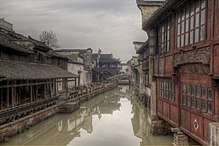
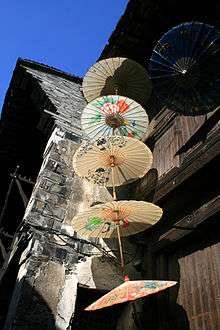
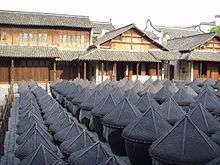
Wuzhen was originally two towns administered by two prefectures, divided by a canal. The two main preserved quarters of Wuzhen today (the "Eastern Quarter" and "Western Quarter") are located on opposite sides of the same canal, and access to them are quite separate. They are based around two old main streets called the "Eastern Palisade" (Dongzha) and "Western Palisade" (Xizha) respectively. Both of these quarters have been comprehensively redeveloped for tourists, are fenced off and charge admission. The areas around the "Northern Pallisade" and "Southern Palisade" (two other old main streets) are also preserved scenic areas, but have not been redeveloped for tourists as much (and still have local residents) and so have less of a "theme park" feel. They are not as scenic, but the Southern Quarter in particular is interesting for a walk that is further off the beaten track, although there are few attractions open to the public. The Northern Quarter has a couple of preserved buildings open to the public, but it has mostly been replaced by modern buildings, so is much less atmospheric. Between the old streets is the modern town centre, which is less atmospheric but has cheaper accommodation than (especially) the Western Quarter.
- Eastern Quarter (东栅, Dongzha) (Main entry is from Ziye Road, near parking lot). Redeveloped and opened as a tourist attraction earlier, the Eastern Quarter or Dongzha features a variety of preserved or restored old-style shops, temples, houses and streets. It has a large variety of small museums and other attractions, but is viewed as slightly less authentic than the Western Quarter, as the restoration process here was less scrupulous in preserving the buildings' original appearance. It is often crowded. The former residence of Mu Xin, 20th century international Chinese artist and writer, is located here. While the Eastern Quarter was also redeveloped, most inhabitants remain (unlike the Western Quarter), although some of them also now operate inns, restaurants and tourist-orientated shops. free to enter street, ¥100 to enter all attractions; ¥150 combined ticket with Western Quarter.
- Western Quarter (西栅, Xizha) (Main entry is from Longyuan Road). Redeveloped later, Xizha or the Western Quarter is larger than Dongzha or the Eastern Quarter, and is based around a network of narrow canals. A boat-bus takes visitors around the quarter. It also features a collection of preserved or restored old-style shops, temples, houses and streets. Some key attractions include the study of an imperial prince from 1,000 years ago, and an ancient theatre. There are also a variety of small museums. It is also often crowded. During the redevelopment process all original inhabitants were moved out, and the only "locals" you will see are those who operate the inns, restaurants and shops in the tourist quarters. As a result, it can feel very much like a theme park. One benefit of the theme park set-up is that the Western Quarter has a larger selection of higher end, but more expensive inns set in traditional houses, so it is the best area to go for a comfortable stay in a traditional house (if you are willing to pay for it). ¥120; ¥80 for evening entry; ¥150 combined ticket with Eastern Quarter.
- Mao Dun residence / Lizhi College (茅盾故居 / 立志书院), Guanqian Street (Located in the "Beizha" or Northern Quarter, but very close to the Eastern Quarter). Mao Dun's residence was the family home of the family of Mao Dun, renowned 20th century Chinese writer and playwright. It is an example of the residence of a well-to-do family of this area. The former Lizhi College is next door, and was an important school of the area. Both buildings together form the Mao Dun Memorial.
Xitang
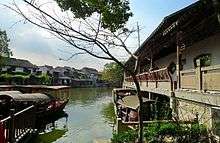
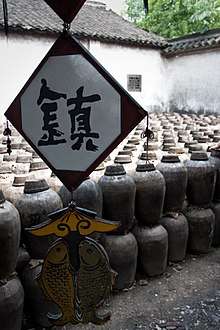
Xitang has remained largely a rural township. The core of the old town has been preserved as a "scenic area", but you can find atmospheric lanes and houses outside the scenic area too.
- Xitang Ancient Town Scenic Area (西塘古镇景区), 258 Nanyuan Road (near Shanjiang Highway) (15 minute walk from main coach/bus station). The core of the old town is a "scenic area". You must buy a ticket if you are entering on the weekend, but you can avoid this fee by visiting on a weekday, after midnight, or simply by entering the "scenic area" via a small lane rather than one of the main gates (the area is not fenced). It gets very crowded every weekend, as daytrippers from Shanghai, Hangzhou and other nearby cities descend on it, and at those times it can feel very little like a quiet canal town. Xitang was a prosperous canal town in ancient times and the town centre (mostly dating from the 17th to 19th centuries) is well preserved - some have likened it to an authentic version of Suzhou. It's easy to get lost in the winding lanes, which might lead you to a dead end by the side of a canal or take you to a crowded stone bridge. The main streets of the old town, however, are entirely taken over by tourist-orientated shops selling souvenirs and knick-knacks, but away from them, many locals still live here. You may well spot locals gutting fish by the canal side as they have done for centuries, just a few feet from art students painting the scenery. At night, its "bar street" (Tangdong Street) is a famed night spot for both visitors and residents of nearby areas. Fierce competition amongst the bars leads to some odd ways to entice customers - such as signs reading "beautiful girls often visit", or a greeter dressed as the monkey-king of Chinese legend. ¥100 (weekends), free weekdays and after midnight on weekends.
Do
- 🌍 Take a boat around South Lake, Nanxi West Road, corner of Haiyantang Road (ticket desk) (Follow signs to main wharf from ticket desk (2-3 mins walk)). Be like the Communist Party's founding fathers, and take a boat onto the South Lake! A regular ferry service takes visitors around South Lake and to the island in the middle of the lake to visit the Pavilion of Mist and Rain and the Communist "Red Boat". Tickets are sold only at the main ticket desk on Nanxi West Road. A ¥60 ticket allows you to get off at each stop, explore the sights, and get on the next boat, while the ¥50 only allows you to get off at the island. All wharves are manned and the attendant can tell you the time for the next boat. The ferry is the best way to see the lake, as it saves the effort of walking around the lake from attraction to attraction. ¥60 (ferry to all destinations); ¥50 (mid-lake island only).
Buy
Eat
- Wu Fang Zhai (五芳斋), 286 West Jianguo Road (建国南路286号). Jiaxing is famed across China for its zongzi, which are compacted parcels of rice and other ingredients wrapped in lotus leaves. The soy sauce-flavoured pork variety is especially popular, but other varieties, both savoury and sweet, also exist. Many shops and restaurants in Jiaxing serve zongzi, but Wu Fang Zhai is by far the best known brand, with several branches just in Jiaxing itself. Wu Fang Zhai's downstairs canteen serves a variety of "small eats" (similar to dim sum) including dumplings and congee as well as zongzi, while the upstairs restaurant serves more upmarket Chinese dishes.
Drink
Sleep
- Zhejiang South Lake 1921 Club Hotel, Yuanhu Road, Nanhu District, e-mail: tprsvns@hubs1.net. A 5-star hotel on the banks of Nanhu Lake. The hotel’s opulence extends to its classic Chinese architecture and gardens transporting visitors to ancient China and the time of the emperors.
- Luoxingge Hotel, No. 335 South Chezhan Road, ☎ +86 57384279999. This 5-star luxury hotel is located in the Jiashan commercial hub on South Chezhan Road. It is also just 4 km from the city center. Their rooms are air-conditioned, and fitted with a cable TV, high-speed Internet, and IDD phone. No. 335 South Chezhan Road Rate start at ¥464.48.
Connect
Go next
Wuzheng and Xitang, two well-preserved canal towns located within Jiaxing city limits, are popular destinations for a taste of "water country" life in the Jiangnan region. They are easy to reach from Jiaxing. Wuzheng can be reached by local train plus bus, while Xitang can be reached by bus from Jiaxing railway station.